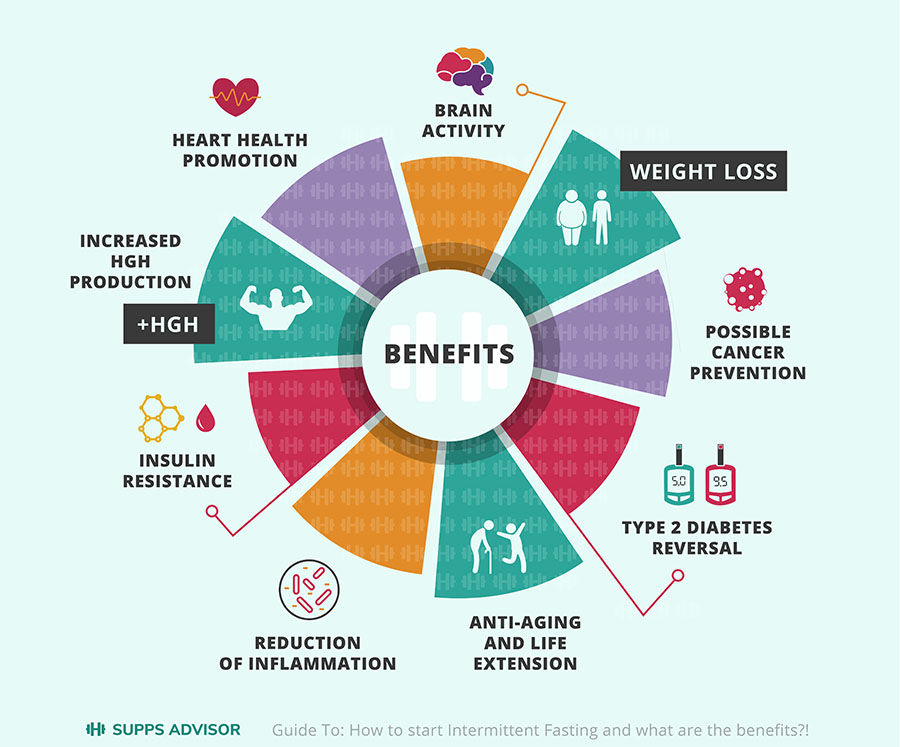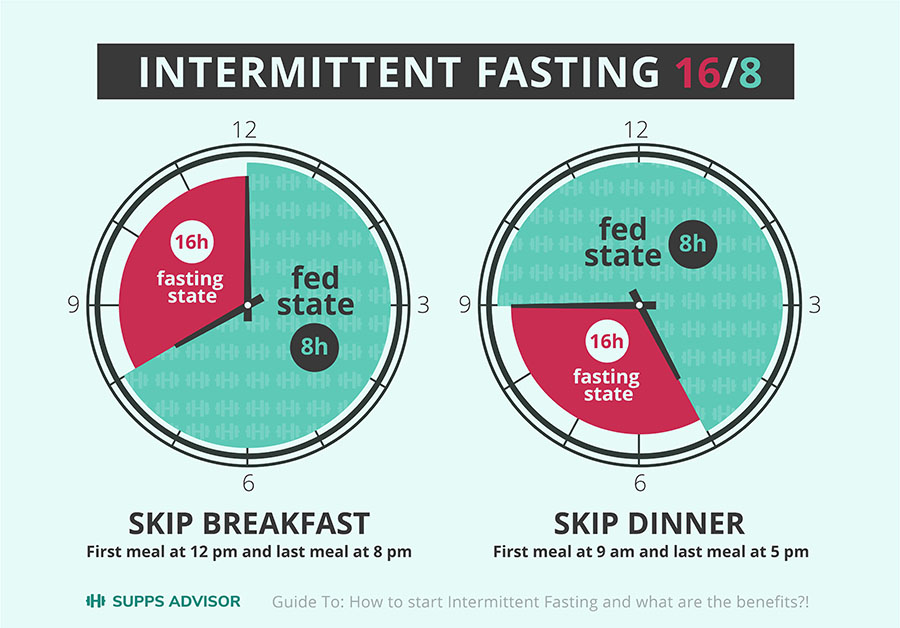It’s no secret that the health and fitness community is fraught with misinformation and fad diets. Most people are looking for an elusive miracle diet, and fad diets make hefty promises. When those promises fall through, people often give up on their nutrition and health. But what if we had a nutrition plan that offers clinically tested benefits with less hassle than fad diets? It sounds too good to be true, but intermittent fasting fits the profile.
Breaking Down How Intermittent Fasting Works
Intermittent fasting [8] involves assigning yourself a window of time to eat your daily calories and fasting the rest of the day. You can choose a method that fits your daily schedule, but keep in mind that it typically takes your body around 12 hours to enter the fasting state.
When we eat throughout the day, we stay in the “fed” state. During digestion, our insulin levels rise, which can inhibit fat loss if we graze throughout the day. The insulin stores glucose in our liver to burn as fuel. From there, the excess glucose converts to fat.
Once we enter the “fasting” state, our insulin levels decrease. The longer we fast, the more we deplete the store of glucose that fuels us, forcing our body to burn fat for fuel instead.
Since it specifically targets fat, you can shed weight without the loss of lean muscle mass. Intermittent fasting is a highly-customizable plan that many people find easier to stick with than diets that rely on calorie/food restrictions.
The Benefits and Advantages of Intermittent Fasting
Intermittent fasting has a wide range of benefits, some of which may surprise you. From beauty to health, fasting shows great promise in scientific studies.
Body Composition, Weight, & Adherence
The primary reasons for the popularity of intermittent fasting are weight loss and body composition. If you want to shed weight or you’re an athlete in the cutting stage, fasting can help target areas of stubborn fat.
The best part is that there are so many ways to tailor your intermittent fasting method to your schedule and goals.
No matter what your goal is, determining your caloric needs using a calorie calculator [7] can help. You have total control of what foods you eat, but you can influence your benefits by using your goal to calculate your macros (protein, fat, and carbs).
If you have dietary restrictions, no problem! Are you on a specific diet such as Keto or Paleo? That’s no problem either! Intermittent fasting pairs well with any food you choose. This makes it easier to adhere to the diet. Where most diets try to force a “one size fits all” narrative, intermittent fasting can mold to individual and unique needs.
Increased Production of Human Growth Hormone (HGH)
Human Growth Hormone (HGH) is an essential hormone for the growth of lean muscle mass. Evidence suggests that your HGH production gets a noteworthy boost [6] during fasting.
Cell Health & Anti-Aging
Fasting improves your health all the way down to your cells. Fasting promotes the waste-removal process [2], “autophagy,” that balances our cell health and regeneration.
Studies show the possibility of this increased cell health aiding cancer prevention [5]. Research also shows the potential for intermittent fasting to ease chemotherapy side effects.
This process also applies to your skin cells. Your skin health can improve with optimized autophagy, leading to an anti-aging effect.
Overall Health
Intermittent fasting can improve several other aspects of your health. This includes:
- Lowering A1C levels [3] in those with type 2 diabetes or insulin resistance
- Lowering blood levels of inflammatory markers [1]
- Decreasing levels of triglycerides and LDL cholesterol [4] (the “bad” cholesterol)
Popular Intermittent Fasting Methods
The following common examples of intermittent fasting are just a few of the choices you have. Everyone is different, so you’ll have to listen to your body and tweak your schedule as you progress.
16:8
This plan, otherwise known as the “Lean-gains” method, is an ideal fit for most people. Having 8 hours to eat and only fasting for 16 hours tends to be more bearable. You can choose when you want your 8-hour eating window to begin, but keep it consistent each day.
If you prefer skipping breakfast, you can assign your eating time from noon to 8 PM. If you prefer more time between your last meal and bedtime, 9 AM to 5 PM might work better. It all comes down to personal preference.
20:4
The 20:4 method is more advanced. Your eating window is cut in half, which can intensify hunger pangs if you’re not used to fasting. For seasoned athletes, this plan can boost your cutting progress.
One Meal A Day (OMAD)
OMAD allows you to eat your daily calorie intake at one mealtime. This method can be very intense for beginners. You may find it difficult to sit down and consume so many calories at once until you adjust.
5:2
Rather than traditional daily methods, the 5:2 plan alternates days. On 2 non-consecutive weekdays, you’ll eat only 500-600 calories. On the other 3 days, you eat only the amount of calories that you burn that day.
24+ Hour Fasts
Some choose to fast for a day or more, up to several days. One common method of fasting is the “Stop, Eat, Stop” method. This involves alternating 24 hours of fasting, followed by a day of normal eating.
Extended fasting involves fasting for more than 36 hours. Extended fasting should always be cleared with your doctor, especially if you have health conditions. Spend plenty of time working your way up to an extended fast.
Tips & Tricks
If you’re interested in starting intermittent fasting, but you feel intimidated by the idea of withholding food, that’s normal. Luckily, there are some tips and tricks to make it an easier adjustment for you.
- Set realistic, healthy goals.
- Calculate your calories and macros [7].
- Keep your mind busy to distract from thinking about food or lack thereof.
- Be patient. It takes around a month to adjust to a new fasting method.
- Track your progress. Have a clear goal in your mind, such as specific weight, BMI, A1C, or body composition numbers. Consistently track your measurement and bask in the pride of seeing progress. If you’re not seeing progress after a month, try tweaking your method.
- Listen to your body. It will tell you if your plan needs adjusted or if something is wrong.
- Take care of your overall health. This includes staying hydrated and getting plenty of sleep. You won’t regret it when you see the progress boost and feel revitalized.
- Be mindful that exercising while fasting can have different effects on different people, and dependent upon the type of exercise performed
IF Safety
It is wise to consult your doctor before you start, especially if you:
- Have any major medical conditions, such as diabetes, heart disease, or blood clotting disorders.
- Have a history of being underweight or anemic
- Are pregnant, trying to conceive, or breastfeeding
- Have a history of eating disorders
- Take any medications
If you experience any new or unusual side effects after you start fasting, stop fasting and call your doctor before continuing. This includes:
- Weakness or fatigue that doesn’t resolve after a month of fasting. Initial fatigue is common, but it should not continue after adjusting.
- Problems controlling your blood pressure or blood sugar levels.
Your body will let you know if something is wrong. Safety is the top priority, so don’t ignore any danger signals your body gives you!
About the Author
Krista Martinez is a freelance writer, SuppsAdvisor contributor, and former Certified Personal Trainer. She’s currently a college student pursuing a bachelor’s degree in Liberal Arts. When she’s not working, you can find Krista playing video games, reading, or working on her novel. You can also guarantee she’ll be listening to her favorite band, Starset. She loves to get active by going for a run or hitting the yoga mat. She hopes to finish her novel soon and see where life takes her!
References
[1] Al-Kurd, R., Bustanji, Y., Fararjeh, M., Faris, M., Kacimi, S., Mohammad, M., & Salem, M. (2012). Intermittent fasting during Ramadan attenuates proinflammatory cytokines and immune cells in healthy subjects. – PubMed – NCBI. Ncbi.nlm.nih.gov. Retrieved 22 April 2020, from https://www.ncbi.nlm.nih.gov/pubmed/23244540.
[2] Alirezaei, M., Flynn, C., Kemball, C., Kiosses, W., Whitton, J., & Wood, M. (2010). Short-term fasting induces profound neuronal autophagy. Ncbi.nlm.nih.gov. Retrieved 22 April 2020, from https://www.ncbi.nlm.nih.gov/pmc/articles/PMC3106288/.
[3] Barnosky, A., Hoddy, K., Unterman, T., & Varady, K. (2014). Intermittent fasting vs daily calorie restriction for type 2 diabetes prevention: a review of human findings. ScienceDirect. Retrieved 22 April 2020, from https://www.sciencedirect.com/science/article/pii/S193152441400200X.
[4] Bhutani, S., Church, E., Klempel, M., & Varady, K. (2009). Short-term modified alternate-day fasting: a novel dietary strategy for weight loss and cardioprotection in obese adults. – PubMed – NCBI. Ncbi.nlm.nih.gov. Retrieved 22 April 2020, from https://www.ncbi.nlm.nih.gov/pubmed/19793855.
[5] Descamps, O., Ducros, V., Riondel, J., & Roussel, A. (2005). Mitochondrial production of reactive oxygen species and incidence of age-associated lymphoma in OF1 mice: effect of alternate-day fasting. – PubMed – NCBI. Ncbi.nlm.nih.gov. Retrieved 22 April 2020, from https://www.ncbi.nlm.nih.gov/pubmed/16126250.
[6] Lee, L. (2020). Why Do HGH Secretions Increase When Fasting? | Livestrong.com. LIVESTRONG.COM. Retrieved 28 April 2020, from https://www.livestrong.com/article/546961-why-do-hgh-secretions-increase-when-fasting/.
[7] Martinez, K. (2019). Macro Calculations: Easy Way to Lose Weight – Supps Advisor. Supps Advisor. Retrieved 28 April 2020, from https://suppsadvisor.com/calories/.
[8] Martinez, K. (2020). Intermittent Fasting: How to start and what are the benefits?. Supps Advisor. Retrieved 28 April 2020, from https://suppsadvisor.com/intermittent-fasting/.





